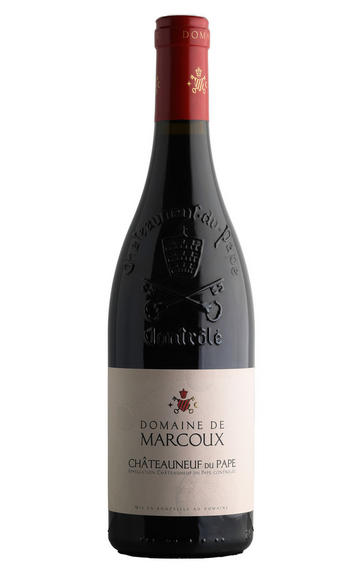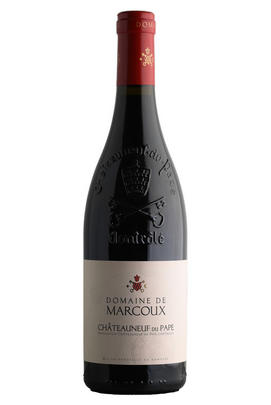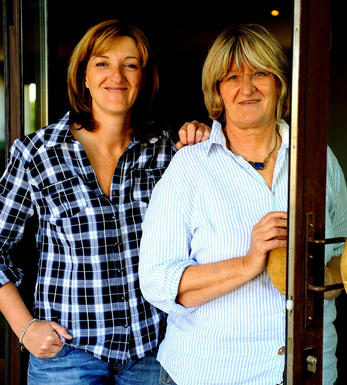
2011 Châteauneuf-du-Pape, Domaine de Marcoux, Rhône

Critics reviews
One of the classic family-owned domaines in Chateauneuf du Pape (of which there are many), Domaine de Marcoux is run by two dynamic sisters, Sophie and Catherine Armenier. The estate, which can trace its history back to 1344, has only been estate bottling since 1978. It owns over 40 acres, all of which have been biodynamically farmed since the early 1990s as this was one of the first properties to move to this strict style of farming. Both cuvees of Chateauneuf du Pape were made in 2011, and in a year that saw a relatively large crop, yields were reduced at Marcoux, averaging 22 liters per hectare. They had to do a Draconian-like triage on the grapes during the harvest. The 2010s are very successful at Domaine de Marcoux.
Robert Parker, Wine Advocate #204, Dec 2012
Jancis Robinson MW, jancisrobinson.com 28 Feb 2013
One of the classic family-owned domaines in Chateauneuf du Pape (of which there are many), Domaine de Marcoux is run by two dynamic sisters, Sophie and Catherine Armenier. The estate, which can trace its history back to 1344, has only been estate bottling since 1978. It owns over 40 acres, all of which have been biodynamically farmed since the early 1990s as this was one of the first properties to move to this strict style of farming. Both cuvees of Chateauneuf du Pape were made in 2011, and in a year that saw a relatively large crop, yields were reduced at Marcoux, averaging 22 liters per hectare. They had to do a Draconian-like triage on the grapes during the harvest. The 2010s are very successful at Domaine de Marcoux.
Robert Parker, Wine Advocate #204, Dec 2012
About this WINE

Domaine de Marcoux
Sisters Sophie and Catherine Armenier have elevated Marcoux to the very highest ranks. Today, Sophie diligently runs the winery, while her son Vincent Estevenin looks after the vineyards. Now, there are 27 hectares split into over 20 parcels: 18 hectares lie right in the heart of the prime Châteauneuf-du-Pape terroir of La Crau plateau. The remainder rest in Lirac and the other Côtes du Rhône villages. Certified as organic by Ecocert as early as 1991, this year marks four decades of rigorous organic and then biodynamic principles.
The domaine makes three main wines: a Lirac, their main Châteauneuf-du-Pape and an exceptional Châteauneuf-du-Pape Vieilles Vignes – the top cuvée from this organically certified domaine. It’s made from two parcels of outstanding, old-vine Grenache: Charbonnières, planted in 2000 and Esqueirons, planted in 1949.
The cool, freshness of the 2021 vintage really plays to Domaine de Marcoux’s stylistic strengths of purity and minerality, aided as ever by their dedication to biodynamics. Their wines are always balanced but, at 1.5% abv lower than in 2020, both the Lirac and the Châteauneuf-du-Pape are especially gorgeous this year. These wines epitomise the crunchy, deliciously fresh appeal of 2021; they are lifted, fruit-forward and fragrant, and such a delight to drink.

Châteauneuf-du-Pape
The most celebrated village of the Southern Rhône, Châteauneuf-du-Pape is the birthplace of the now indispensable French Appellation d’Origine Contrôlée system – imperfect though it may be. Compared to the Northern Rhône, the vineyards here are relatively flat and often feature the iconic galet pebbles – the precise benefits of which are a source of much debate. Minimum alcohol levels required by the AOC are the highest in France, but at 12.5% it is well below the natural generosity of Grenache, which only achieves its full aromatic potential when it is fully ripe and laden with the resultant high sugars. Syrah and Mourvèdre contribute the other defining elements in the blend, adding pepper, savoury spice and structure to the decadent Grenache. There are a further 10 permitted red grape varieties which can be used to adjust the “seasoning”. Of the five white varieties permitted, it is Grenache Noir’s sibling – predictably perhaps – Grenache Blanc, which dominates, though Roussanne shows a great deal of promise when handled well, notably at Château de Beaucastel.

Southern Rhône Blend
The vast majority of wines from the Southern Rhône are blends. There are 5 main black varieties, although others are used and the most famous wine of the region, Châteauneuf du Pape, can be made from as many as 13 different varieties. Grenache is the most important grape in the southern Rhône - it contributes alcohol, warmth and gentle juicy fruit and is an ideal base wine in the blend. Plantings of Syrah in the southern Rhône have risen dramatically in the last decade and it is an increasingly important component in blends. It rarely attains the heights that it does in the North but adds colour, backbone, tannins and soft ripe fruit to the blend.
The much-maligned Carignan has been on the retreat recently but is still included in many blends - the best old vines can add colour, body and spicy fruits. Cinsault is also backtracking but, if yields are restricted, can produce moderately well-coloured wines adding pleasant-light fruit to red and rosé blends. Finally, Mourvèdre, a grape from Bandol on the Mediterranean coast, has recently become an increasingly significant component of Southern Rhône blends - it often struggles to ripen fully but can add acidity, ripe spicy berry fruits and hints of tobacco to blends.


Buying options
Add to wishlist
Description
This is a blend of 80% Grenache, 10% Mourvèdre, 7% Syrah and 3% Cinsault. The wine has been aged in concrete and wooden tronconique vats, with extensive remontage used to ensure the freshness of the tannins. The wine has an attractive perfume of violets and thyme and then a delightful weight on the palate with black cherry fruit and hints of graphite and spice. It wears its alcohol lightly, with plenty of feminine charm.
Simon Field MW, BBR Buyer
Domaine Marcoux are now definitive A-listers in the Châteauneuf-du-Pape firmament and we are delighted to be working more closely with them. The domaine, which dates from the time of the 100 Years War, has been run along biodynamic principles for 20 years by sisters Anne and Sophie Armenier. 2011 was a year that they found relatively challenging. Some of the grapes refused to ripen at all, the crop was therefore short after the need for both extensive green harvesting and triage (sorting) both in the vineyards and the winery. Those which did ripen, that is to say the happy majority, have fared extremely well.
wine at a glance
Delivery and quality guarantee